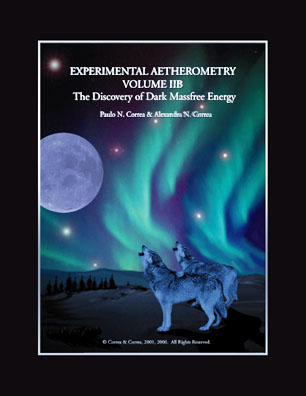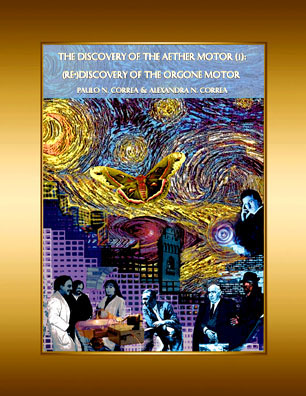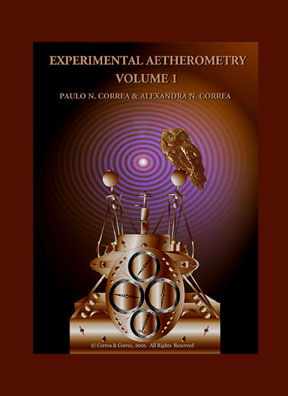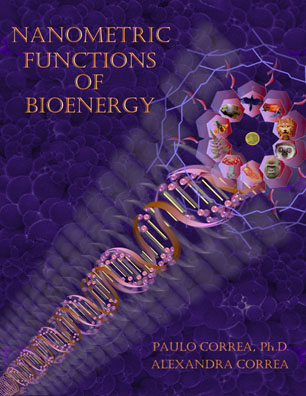Pages: 370
Publisher: Akronos Publishing
Year: 2006
ISBN: 0968906028
Websites: www.aetherometry.com www.aetherenergy.com
But the present volume goes well beyond rediscovery. It is the articulation of a new physics of electricity, for massbound and massfree charges. It lays the foundations for a novel electrodynamics. It proposes a radically different theory of electromagnetism, in particular blackbody photons and 'sunlight', and how these spectra are generated by the electric Aether. It gives new critical insights into the chemical structure and allotropic processes of the terrestrial atmosphere (formation of water, oxygen, hydrogen and ozone). Solar radiation is finally understood as massfree electric energy, and its spectrum is for the first time provided. Finally, this seminal work shatters the accepted cosmological and astrophysical interpretations of the microwave Cosmic Background Radiation (CBR), by way of (1) a new model for the creation of Matter from Dark Massfree Energy, (2) identification of the latter's cosmic spectrum (CBOR) and (3) an energy-based articulation of the Space and Time manifolds. In the words of the authors: "We challenge radioastronomers and NASA to determine whether or not we are correct in predicting radio CBRs from cosmological baryons (hydrogen and helium in particular) in extragalactic space".
Tesla was convinced that ambipolar radiation could not be reduced to fluxes of monopolar charges (massbound electricity) or to electromagnetic radiation, but he failed to adequately distinguish it from either of these. Likewise, Reich failed to provide the energy and frequency spectra of OR and DOR radiation or to concretely identify his concept of 'orgonotic charges' - which confusedly shared both electric and nonelectric characteristics. Before this groundbreaking work, no one had discovered the spectrum of massfree electric energy, described its characteristics, or studied its physical interactions. The present work does just this, by bringing its scientific methodology to bear upon both the strengths and the shortcomings of the approaches of Tesla and Reich, breaking the mythological stronghold that has surrounded them and which for so long has impeded a legitimate scientific understanding of their endeavors. For the first time, the spectrum of the electric Aether (Tesla waves), with its DOR and OR subspectra, is clearly identified - and so is the nature of massfree ambipolar energy. For these reasons, this volume could have been called "The Discovery of Massfree Electricity", were it not also the discovery of the nonelectric Aether - the latent energy of the continuum of Space and Time.
Pages: 343
Publisher: Akronos Publishing
Year: 2006
ISBN: 0968906036
Websites: www.aetherometry.com www.aetherenergy.com
In the second volume of this series, the Correas go beyond the principles of the Orgone Motor to develop a full Aether Motor/Converter. These two books are also part of the journey of Experimental Aetherometry (constituting volumes IIIA and IIIB of the series of that title), and mark the moment of its technological culmination. They present the reader with a new technology - the power technology of massfree energy - that employs both forms of the primary Aether, electric and nonelectric: ambipolar (Tesla) energy and latent heat. A comprehensive index of both works is scheduled to accompany the release of the second volume.
In the present volume, the Correas present the main principles behind the Aether Motor/Converter. In broad terms, these concern: operation of resonant ambipolar transmitters; the decoding and identification of Reich's secret Function Y that served as key to operating the Orgone Motor; the receiver circuit required to magnify the transmission and convert latent heat into ambipolar electricity; and the plasma and plasma-less methods employed to drive drag-cup motors and Reich's Spinners - KS-8624 and KS-9154 - or to charge batteries and capacitors. Included also is the extraordinary history of these KS-series motors and their special applications.
This book marks the beginning of a new age in science and technology - the age of massfree energy. It has been long in coming - but, at last, our epoch may be able to begin to understand and utilize intelligently the work of those two pioneers who laid the foundations for massfree science and technology: Nikola Tesla and Wilhelm Reich. May these volumes stand as a tribute to both of them, to their perseverance and to the finest of perceptive intelligences.
Pages: 404
Publisher: Akronos Publishing
Year: 2004 2nd ed.
ISBN: 0968906001
Websites: www.aetherometry.com www.aetherenergy.com
In this fascinating, seminal work, the Canadian biophysicists Dr. Paulo Correa and Alexandra Correa provide a step-by-step exposition of their path-breaking discovery and investigation of the nature and structure of massfree energy. It is a book for all who have a serious interest in understanding nature. The first volume focuses on the discovery and study of the kinetoregenerative action of massfree energy (specifically, its 'latent heat' component) in slowing down, or arresting, the spontaneous discharge of electroscopes, as well as the role of this energy in producing the thermal anomalies observable with certain metal enclosures.
This First Volume of Experimental Aetherometry provides, for the first time in the history of science and with new methodologies, a solid, in-depth study and analysis of the thermal and electroscopic anomalies originally discovered by Wilhelm Reich, and described by him as demonstrations of the benign effect of special enclosures that he called orgone accumulators (ORACs). The thermal anomaly is characterized by a constant positive temperature difference between the space at the top of the inner metallic layer of an ORAC and the surrounding atmosphere. The electroscopic anomaly is characterized by the fact that charged electroscopes discharge more slowly inside an ORAC than outside of it.
In the course of this exploration of the two fundamental ORAC phenomena, the Correas verify the two basic anomalies proposed by Reich, reproduce the Reich-Einstein experiment with a Faraday cage under stringent conditions and with novel controls, propose a new treatment of the electric and nonelectric (gravitational) interactions of massbound charges trapped in the conduction band of metals, examine the behavior of atmospheric electroscopes with respect to meteorological and geophysical functions, demonstrate electroscopic arrest induced by the midday Sun, introduce a novel experimental model for the charging of electroscopes, identify the distinctive electroscopic response of living systems, determine the blackbody spectra of ORACs, optimize the ORACs' production of anomalous sensible and latent heats, show how the slowing down of the electroscopic discharge by ORACs occurs independently from the polarity of the charged electroscope and often reaches complete arrest of the discharge, create a novel method to determine the latent heat accumulated inside ORACs, and discuss the problems with the fundamental concepts of orgonometry.
For those interested in new physics or the physics of the massfree Aether, this is an indispensable, ground-breaking publication that lays down some of the most fundamental tools of the new science of Aetherometry.
Pages: 265
Publisher: Akronos Publishing
Year: 2004
ISBN: 096890601X
Websites: www.aetherometry.com www.aetherenergy.com
In volume 2A of their ground-breaking work, Dr. Paulo Correa and Alexandra Correa embark on an experimental journey of discovery of ambipolar radiation. This leads them from a re-examination of the photo-electric effect, to a new model of the photon, and the differentiation of two types of electricity: massbound (or monopolar), and massfree (or ambipolar).
This first part of the Second Volume of Experimental Aetherometry lays the foundations for the discovery of a new form of energy - longitudinal massfree ambipolar radiation - that has, for over a century and until this work, been thoroughly confused with electromagnetism, eluding analytical isolation by the methodology of accepted physical theory.
The Volume opens up with the Correas' discovery of the photo-induced arrest of the spontaneous electroscopic discharge. This is a stunning confirmation of the Correas' proposed distinction between two different types of blackbody photons, with very different physical, chemical and biological effects. By applying the novel methodologies they pioneered to the allotropic cycle of the terrestrial atmosphere, the authors lay the basic groundwork for the new discipline of "aetherochemistry", and distinguish it from both radiochemistry and photochemistry. They also balance, for the first time, the enthalpy of the atmospheric cycle of ozone, oxygen and water. At the core of the present Volume, the reader will be engaged by an entirely novel physico-mathematical investigation of the relations between the electromagnetic field, the gravitational field, and the two main forms (electric and nonelectric) of the dynamic Aether - ambipolar radiation ("Dark energy") and latent heat. This leads to a surprising encounter between aetherometric science and natural philosophy (the thoughts of Spinoza, Leibniz and Deleuze in particular) on the one hand, and to a new, unsuspected conjunction between the natural researches of Tesla and Reich, on the other. An initial approach is also made to redefining the basic functions of the theory of electricity. The role of secondary superimposition of aether energy in the creation of Matter, and its essential functions in the generation of the gravitational field, in aetherochemical cycles, in emission phenomena and in the electroscopic kinetoregenerative phenomenon, are also introduced, along with their conventional or experimental evidence.
The Volume ends with a long study which, for the first time, physically and analytically identifies Tesla radiation as massfree, longitudinal, ambipolar energy, and links up with the problematics of Reich's investigations of orgone energy using radiation counters, Tesla coils and antennas. The findings clearly demonstrate that what Reich meant by massfree orgone energy (and, also, by DOR energy) can only be identical to what Tesla meant by longitudinal electric wave energy or Aetherometry means by ambipolar radiation. However, the experimental and analytical tools that both Reich and Tesla lacked and sorely needed to establish the distinct reality of this energy could never have come to fruition other than through Aetherometry and its box of tools. This will lead, in the next Volume, to the complete identification of the ambipolar continuum and its spectra, along with a complete physico-mathematical treatment of massfree ambipolar energy.
Pages: 452
Publisher: Akronos Publishing
Year: 2004
ISBN: 1894840291
Websites: www.aetherometry.com www.aetherenergy.com
In the first of two volumes on the theory of aetherometric biophysics, the Correas lay the nanobiological foundations for the understanding of the interaction of massfree energy with bio-molecular processes. Highlights include a new model of system dynamics (order and entropy), a new electrochemical scale, a compelling argument for the multiple nanometric and molecular origins of Life, and an investigation into the bioenergetic role of fundamental biomolecules (DNA, RNA, globins, ATP, etc). Introduction by Dr. E. Mallove. A must read for all scientists and the lay public interested in science.
Could there be an intimate physical relationship between the molecular structure of DNA/RNA with its protein machinery, and the nanometric structure of the energies deployed by biological systems? What are these energies? Do they always bear mass? Are they always affected to mass? And what is the nature of that intimate physical relationship? What defines a biological system? Do disorder and entropy always increase in parallel? Does negentropy have a physical sense? Is there an energetic specificity to the living, or is biological specificity merely and solely molecular? Are there submolecular specificities to the living?
These insistent questions are fundamental problems of molecular and submolecular biology which the present book - Volume One of the Foundations Aetherometric Biophysics - addresses from an entirely novel perspective. The authors develop the aetherometric method and introduce the reader to its application in the nanometric domains of bioenergetic physics, biochemistry, systems theory, and molecular biology. What emerges is a very different view of Life and living systems than has been proposed by previous theories of Biology - be they stochastic, mechanistic, deterministic, or vitalistic, mystical or animistic. Even the topic of the submolecular properties of water is explored anew - well beyond present-day nanochemical understanding. From the massfree energy level, to the submolecular, the molecular and the cellular, Nanometric Functions of Bioenergy tracks the imprints of complex and subtle energies responsible for biological submolecular functions and the creation of structure on both micro and macro scales. Living systems may, at last, be analytically grasped in their functional complexity as systems capable of superimposing very different types and orders of energy, both electromagnetic and nonelectromagnetic, in polar regimes of assemblage - in short, as systems of superimposition, accumulation and interconversion of energy.







